Potrebujeme váš súhlas na využitie jednotlivých dát, aby sa vám okrem iného mohli ukazovať informácie týkajúce sa vašich záujmov. Súhlas udelíte kliknutím na tlačidlo „OK“.
ASTM D7783-13
Standard Practice for Within-laboratory Quantitation Estimation (WQE)
Automaticky preložený názov:
Štandardná prax pre stanovenie 99% / 95% kritickej úrovne (SKP) a spoľahlivú detekciu Odhad (WDE) Na základe v rámci laboratória dát
NORMA vydaná dňa 28.3.2013
Informácie o norme:
Označenie normy: ASTM D7783-13
Poznámka: NEPLATNÁ
Dátum vydania normy: 28.3.2013
Kód tovaru: NS-39108
Počet strán: 13
Približná hmotnosť: 39 g (0.09 libier)
Krajina: Americká technická norma
Kategória: Technické normy ASTM
Kategórie - podobné normy:
Anotácia textu normy ASTM D7783-13 :
Keywords:
critical limits, matrix effects, precision, quantitation, quantitation limits, ICS Number Code 17.020 (Metrology and measurement in general)
Doplňujúce informácie
| Significance and Use | ||||||||||||
|
5.1?Appropriate application of this practice should result in a WQE achievable by the laboratory in applying the tested method/matrix/analyte combination to routine sample analysis. That is, a laboratory should be capable of measuring concentrations greater than WQEZ %, with the associated RSD equal to Z % or less. 5.2?The WQE values may be used to compare the quantitation capability of different methods for analysis of the same analyte in the same matrix within the same laboratory. 5.3?The WQE procedure should be used to establish the within-laboratory quantitation capability for any application of a method in the laboratory where quantitation is important to data use. The intent of the WQE is not to impose reporting limits. The intent is to provide a reliable procedure for establishing the quantitative characteristics of the method (as implemented in the laboratory for the matrix and analyte) and thus to provide the laboratory with reliable information characterizing the uncertainty in any data produced. Then the laboratory may make informed decisions about censoring data and has the information necessary for providing reliable estimates of uncertainty with reported data. |
||||||||||||
| 1. Scope | ||||||||||||
|
1.1?This practice establishes a uniform standard for computing the within-laboratory quantitation estimate associated with Z % relative standard deviation (referred to herein as WQE1.2?WQEZ % is computed to be the lowest concentration for which a single measurement from the laboratory will have an estimated Z % relative standard deviation (Z % RSD, based on within-laboratory standard deviation), where Z is typically an integer multiple of 10, such as 10, 20, or 30. Z can be less than 10 but not more than 30. The WQE10 % is consistent with the quantitation approaches of Currie (1)2 and Oppenheimer, et al 1.3?The fundamental assumption of the WQE is that the media tested, the concentrations tested, and the protocol followed in the developing the study data provide a representative and fair evaluation of the scope and applicability of the test method, as written. Properly applied, the WQE procedure ensures that the WQE value has the following properties: 1.3.1?Routinely Achievable WQE ValueThe laboratory should be able to attain the WQE in routine analyses, using the laboratorys standard measurement system(s), at reasonable cost. This property is needed for a quantitation limit to be feasible in practical situations. Representative data must be used in the calculation of the WQE. 1.3.2?Accounting for Routine Sources of ErrorThe WQE should realistically include sources of bias and variation that are common to the measurement process and the measured materials. These sources include, but are not limited to intrinsic instrument noise, some typical amount of carryover error, bottling, preservation, sample handling and storage, analysts, sample preparation, instruments, and matrix. 1.3.3?Avoidable Sources of Error ExcludedThe WQE should realistically exclude avoidable sources of bias and variation (that is, those sources that can reasonably be avoided in routine sample measurements). Avoidable sources would include, but are not limited to, modifications to the sample, modifications to the measurement procedure, modifications to the measurement equipment of the validated method, and gross and easily discernible transcription errors (provided there was a way to detect and either correct or eliminate these errors in routine processing of samples). 1.4?The WQE applies to measurement methods for which instrument calibration error is minor relative to other sources, because this practice does not model or account for instrument calibration error, as is true of quantiation estimates in general. Therefore, the WQE procedure is appropriate when the dominant source of variation is not instrument calibration, but is perhaps one or more of the following: 1.4.1?Sample Preparation, and especially when calibration standards do not go through sample preparation. 1.4.2?Differences in Analysts, and especially when analysts have little opportunity to affect instrument calibration results (as is the case with automated calibration). 1.4.3?Differences in Instruments (measurement equipment), such as differences in manufacturer, model, hardware, electronics, sampling rate, chemical-processing rate, integration time, software algorithms, internal signal processing and thresholds, effective sample volume, and contamination level. 1.5?Data Quality ObjectivesFor a
given method, one typically would compute the lowest % RSD possible
for any given data set. Thus, if possible, WQE10 % would be computed. If the
data indicated that the method was too noisy, one might have to
compute instead WQE
Adjunct to D7510 Standard Practice for
Performing Detection and Quantitation Estimation and Data
Assessment Utilizing DQCALC Software, based on ASTM Practices D6091
and D6512 of Committee D19 on Water and D2777 Standard Practice for
Determination of Preci Standard Practice for Performing
Detection and Quantitation Estimation and Data Assessment Utilizing
DQCALC Software, based on ASTM Practices D6091 and D6512 of
Committee D19 on Water (Includes all amendments and changes
12/29/2016). Adjunct to D7510 Standard Practice for
Performing Detection and Quantitation Estimation and Data
Assessment Utilizing DQCALC Software, based on ASTM Practices D6091
and D6512 of Committee D19 on Water and D2777 Standard Practice for
Determination of Preci Standard Guide for Interpretation and Use
of Results from Interlaboratory Testing of Chemical Analysis
Methods (Withdrawn 2015) Standard Terminology Relating to Water
(Includes all amendments and changes 2/14/2024). Standard Practice for Determination of
Precision and Bias of Applicable Test Methods of Committee D19 on
Water |
Podobné normy:
Historická
1.9.2014
Historická
1.10.2004
Historická
1.1.2013
Historická
15.1.2014
Historická
1.11.2006
Historická
1.5.2010


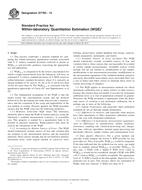
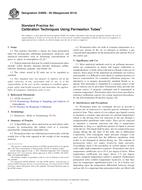 ASTM D3609-00(2014)..
ASTM D3609-00(2014)..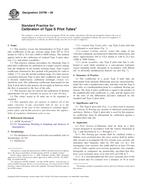 ASTM D3796-09
ASTM D3796-09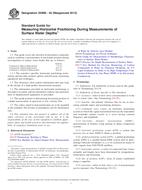 ASTM D5906-02(2013)..
ASTM D5906-02(2013)..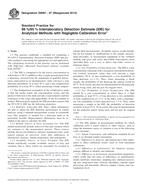 ASTM D6091-07(2014)..
ASTM D6091-07(2014).. ASTM D6475-06
ASTM D6475-06 ASTM D7510-10
ASTM D7510-10
 Cookies
Cookies
